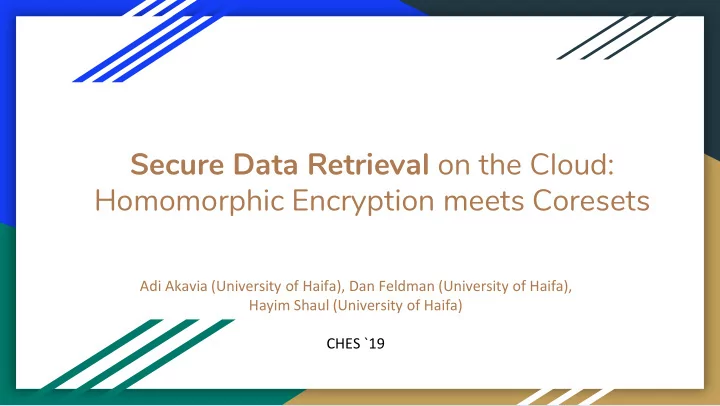

Secure Data Retrieval on the Cloud: Homomorphic Encryption meets Coresets Adi Akavia (University of Haifa), Dan Feldman (University of Haifa), Hayim Shaul (University of Haifa) CHES `19
Motivation ● Useful building block - many applications ● Shows link between secure computation and coresets 2
Motivation IsMatch(d i ,q) = x i ∈ {0,1} Many algorithms follow these lines: Input: n items (d 1 ,...,d n ) Find: items that match a filter Report: those items 3
Problem - Efficient w.r.t. communication Input: n items (d 1 ,...,d n ) Query: a filter IsMatch(.,q) IsMatch(d i ,q) = x i ∈ {0,1} Report: All indices i such that x i = 1 Easy to extend: report d i s.t. x i =1 Many indices - report all. We therefore assume at most s << n matches We want: comm. complexity = function of s 4
Additive/Fully Homomorphic Encryption 5
Fully Homomorphic Encryption (FHE) Public key encryption scheme. Enc (x, pk) = [x] Dec ([x], sk) = x Dec( Add ([x], [y]) ) = x+y [x]+[y] ; [x]+y Dec( Mul ([x], [y]) ) = xy [x][y] ; [x]y = [x]+[x]+[x]+... 6
Any algorithm can be implemented Any polynomial can be evaluated with FHE Any algorithm can be expressed as a polynomial of the input Objective: keep the degree small 7
Our Results Our Results Direct Approach Report all s Degree: d Degree: O(d n) Comm: O(s 2 log 2 n) matches Comm: O(s log n) Client: (s log n) O(1) Client: O(s log n) d = degree(isMatch) 8
Example: Report all DD <1 mile away Input: Dunkin store gps (d 1 , …, d n ) A Dunkin service to find Query: [location] the nearest store n = Gazillion s < 10 x i = isMatch(d i , [location]) Without telling where you are. dist(d i , [location]) < 1mile Without downloading the Report i s.t. x i =1 entire database. 9
Direct Approach Input: binary (x 1 , …, x n ) with at most s 1 ’s Output: Output[1] - index of 1 st 1 in (x 1 , …, x n ) Output[2] - index of 2 nd 1 in (x 1 , …, x n ) … Output[s] - index of s th 1 in (x 1 , …, x n ) 10
Direct Approach (1 ,0,0,…, 1,0,0,1,0,0,1 … ) Output[t] = Σ n j=1 j · x j · isEqual(x 1 +x 2 +...+x j-1 , t-1) isEqual(a,b) = returns 1 if a=b , 0 otherwise. Tests if there are (t-1) matches in x 1 , … , x j-1 Using Fermat’s Little Theorem: isEqual(a,b) = 1 - (a-b) p-1 mod p Since p > n the degree is ϴ(n) 11
Coresets for FHE ( x 1 , x 2 , …, x n ) “Borrowed” from computational geometry: decode C is a coreset of P if: (1) C is short ( [x 1 ], [x 2 ], …, [x n ] ) (2) P := Decode(C) is efficient decrypt We will transform (x 1 ,...,x n ) to a different representation to improve performance. 12
Indyk-Ngo-Rudra (2010) Sketch A (s,n) sketch matrix Sϵ{0,1} kxn transforms a long vector x ϵ{0,1} n with at most s 1’s into a short vector y= S · x ϵ{0,...,s} k s.t. there exists Decode alg., where x=Decode(y) . 13
Example (1,7) Sketch Matrix 1 ) ( 0 ) 0 0 0 0 1 1 1 0 ( 1 0 0 1 1 0 0 1 1 S = 0 0 1 0 1 0 1 0 1 Because multiplying by a 1-sparse vector xϵ{0,1} 7 with 1 at the i -th place gives the i -th column of S which is the binary rep. of i . Decode: parse binary value. 14
Indyk-Ngo-Rudra (2010): For every s,n exists a (s,n) -sketch matrix Sϵ{0,1} kxn With k=O(s 2 log n) and decode time Poly(k) 15
Coresets for Report ( 0, 1, …, 0 ) Decode S [x] [x] = ( [0], [1], …, [0] ) Decrypt 16
Polynomial Degree Analysis Since Sϵ{0,1} kxn is clear text, multiplying S[x] can be done by adding elements of x. The Degree is therefore 1. - Additive HE is enough. 17
Experimental Results ● HElib ● 64 cores 18
Conclusion ● Using coresets we can improve performance ● Report a s sparse vector of size n requires only additive HE Open Problems ● More coreset applications ● Improve constants 19
Thank You 20
Recommend
More recommend